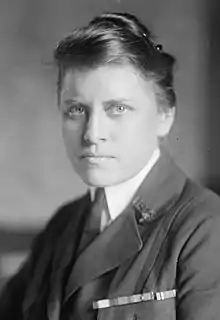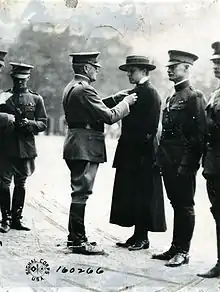Julia Catherine Stimson
Julia Catherine Stimson RRC (May 26, 1881 – September 30, 1948) was an American nurse, credited as one of several persons who brought nursing to the status of a profession.[1]
Julia Catherine Stimson | |
|---|---|
 Stimson in 1920 | |
| Born | May 26, 1881 |
| Died | September 30, 1948 (aged 67) |
| Allegiance | |
| Service/ | |
| Rank | |
| Commands held | Superintendent of the Army Nurse Corps |
| Battles/wars | World War I |
| Awards | Distinguished Service Medal |
| Alma mater | |
Early life
Julia Catherine Stimson was born in Worcester, Massachusetts 26 May 1881. Her parents were the Reverend Henry A. Stimson and Alice Bartlett Stimson. She had five siblings: Dr. Barbara B. Stimson, Dr Philip M. Stimson, Elsie Stimson Smith, Lucile Stimson Harvey and Henry B. Stimson. She was also first cousin to Secretary of War and Secretary of State Henry L. Stimson. She received her bachelor's degree from Vassar College in 1901, then received a degree from the New York Hospital Training School for Nurses in 1908. She held a number of administrative posts in New York City and Missouri, where she received her master's degree from Washington University in St. Louis in 1917. She volunteered for military service in April 1917.[2]
Military career

As superintendent of the Army Nurse Corps during World War I, Stimson became the first woman to attain the rank of Major (United States) in the United States Army. Mary T. Sarnecky, author of A History of the U.S. Army Nurse Corps (Penn Press, 1993) wrote, "Stimson actively lived a feminist ideology in several singularly oppressive and paternalistic contexts--the upper-class Victorian home, the turn-of-the-century hospital setting and the military establishment of the early 20th century." [3]
Thousands of women nurses enlisted in the Corps, and returned from the War as both professionals and veterans. Stimson herself was awarded the United States Distinguished Service Medal,[4] presented by General John J. Pershing. She was also awarded the Royal Red Cross.[5] Though she retired from the Army in 1937, Stimson returned after the outbreak of World War II as chief of the Nursing Council on National Defense, and recruited a new generation of women to serve as nurses. She was promoted to full colonel in 1948, shortly before her death.[6] Stimson, who served as President of the American Nursing Association from 1938 to 1944, was inducted into that association's Hall of Fame in 1976.[7]
Her papers are housed at the Weill Cornell Medical Center Archives.[8]
Awards
Bibliography
- Stimson, Julia Catherine (1918). Finding Themselves: The Letters of an American Army Chief Nurse in a British Hospital in France. New York: Macmillan Company.
References
- "Julia Catherine Stimson and the Mobilization of Womanhood"
- Julia Stimson obituary, Poughkeepsie New Yorker, 20 September 1948
- M.T. Sarnecky, Julia Catherine Stimson: nurse and feminist, 1: Image J Nurs Sch. 1993 Summer;25(2):113-9.
- General Orders No. 70, 1919, War Department, as cited by "Valor awards for Julia C. Stimson". militarytimes.com.
- "Nursing News and Announcements". The American Journal of Nursing. XIX (12): 964. September 1919.
- Marion Hunt, "Julia Catherine Stimson and the Mobilization of Womanpower" Gateway Heritage, Winter 1999-2000 vol. 20, no. 3.
- - American Nurses Association
- Guide to the Julia Stimson, RN Papers
- "The Florence Nightingale Medal" American Journal of Nursing (September 1949): 580.
External links
| Wikimedia Commons has media related to Julia Catherine Stimson. |